ON CURATING
A view notes prepared for the panel "When Artists Curate" at Sotheby’s Institute of Art, New York, July 24, 2018
Moderated by Dr. Kathy Battista, MA Contemporary Art Faculty, Sotheby's Institute of Art, the panel features Dr. Alison Green, Course Leader of MA Culture, Criticism and Curation at Central Saint Martins, London, Dr. Michael Corris, Professor of Art, Meadows School of the Arts, Southern Methodist University, Dallas, Texas, and Rainer Ganahl, New York-based artist.
see a text at the botom of page inspired by two of the moderators question:
When attitudes become - curating, 2004
-------
below see a selection of curatorial projects of mine while being an arist -
in green text, you can find what matters for this presentation
-------
Generali Foundation, EDUCATIONAL COMPLEX, Vienna, 1996
a show that was planned as a one person show and where i have used most of the wall space, I opted (together with curator, Sabine Breitwieser) to include also specific pieces that helped me to contextualize my seminar lecture worrsk.. Mike kelley's educational complex related talko of puppet intellectuals, Li, Candiad Hoefer, s library images, IF, 1968 by Lindsay Anderson and Fredik wiessman,
3 imes, 3 weeks, ROGER PAILHAS, PARIS, 1992
Peter Fend, Rainer Ganahl, Silvia Kolbowski, curated by Rainer Ganahl), Paris, catalgue
This show was curated on a diachronical axis, 3 one person show after another. I invited a friend, Peter Fend and a teacher from the Whitney Independent Study program.
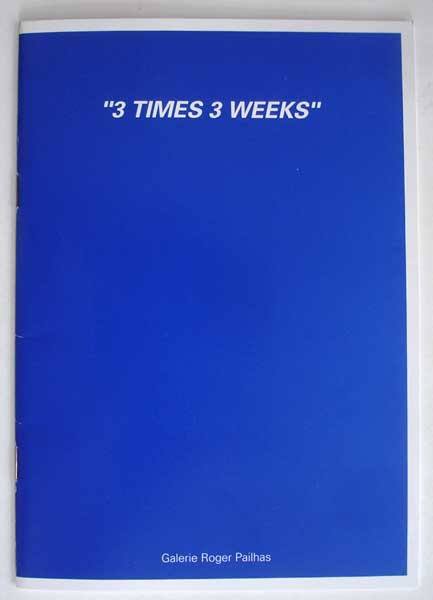
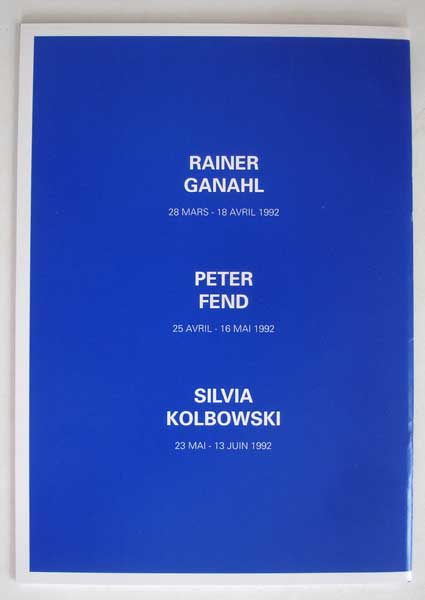
Roger Pailhas, Marseille, Paris,
Basel Art Fair, Booth, curated, presentented and furniture design by Rainer Ganahl, 1993
My idea was to create a slide show theater with exclusive presentation of all the works on slide. Three slide projectors were used. I designed two tables, 8 chairs, three stands for slide projecters, and asked to make a black box with white projection surfaces and white entrace border.The booth was covered with a roof.
I curated all artists of the gallery in form of 3 slide projections wiht a clear no to video works as it would have bothered the clicking and teh periodicity of the slieds. The presentation of works included Dan Gaham, Jeff Wall, John Knight, Daniel Burren, Pierre Huyghe, Atelier Van Lieshout, Stephan Balkenhol, Elija-Liisa Ahtiila, Peter Fend, Rainer Ganahl and more.
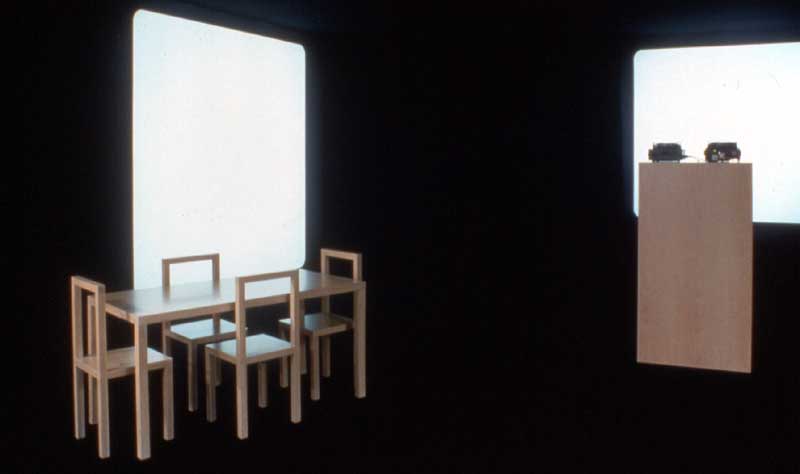
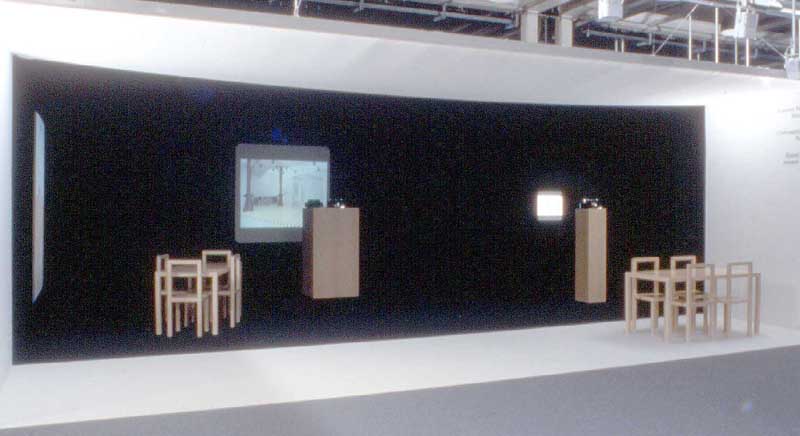
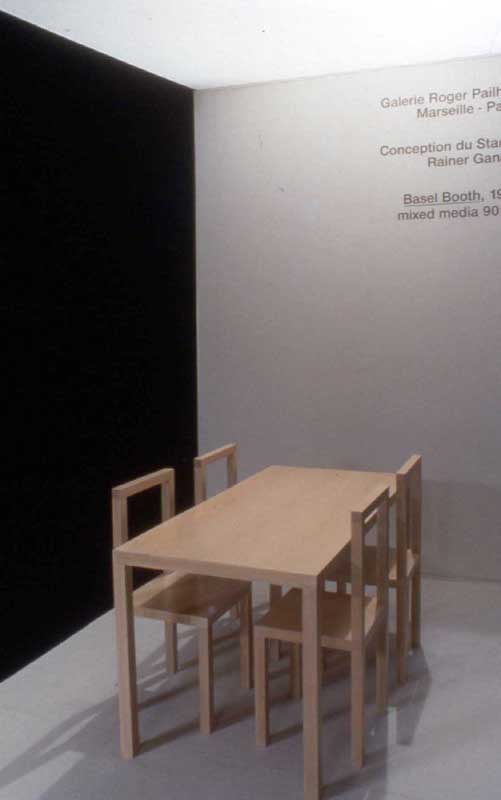
1994
ART AFTER COLLECTING, PHILOMENE MAGERS (today, Sprueth Magers), 1994
JENNINE ANTONI, ANDREA ZITTEL, TODD ALDEN, RAINER GANAHL, DEVON DIKEOU. BETH HAGGART, LISA HEIN, RIRKRIT TIRAVANIJA
This show included just friends who all showed the first time in Europe and were totally unknown at that time to a European, as well as a wider NYC public
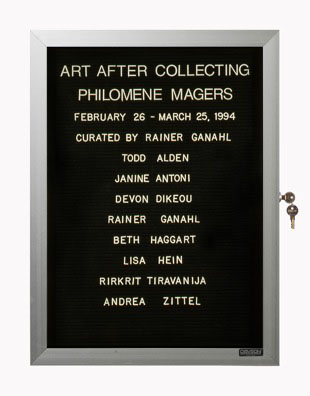
2015
TABLEAU, Kai Matsumiya, New York, 2015
(June 30th - August 9th)
Opening Reception: Tuesday, June 30th (7-9 pm)
artists: Daniel Spoerri, Natascha Sadr Haghighian, B. Wurtz, Josh Tonsfeldt, Trevor Shimizu, Brent Owens, Pedro Wirz, Fabian Drung, Gelitin, Margaret Lee, Rainer Ganahl, Heike-Karin Föll, David Adamo, Robert Mapplethorpe, Marcel Duchamp
http://kaimatsumiya.com/tableau
This stomach driven show was a curatorial treat by Kai Matsumiya, the lower east side gallery that represents me in New York. He invited me to curate and offered me carte blanche. At that time, I was working on my Credit Crunch series that comment on the cascading economic, social and political consequences of the post 2008 GREAT RECESSION area, expressed in food, food decay and porcelain. I decided to propose a show around food with mostly works from my collection or from friends to create some kind of frozen "dinner party"- hence a tableau, a tableau mort, a nature morte, a still life.. At the opening i donated jars of home made marmelades as i also love to cook.
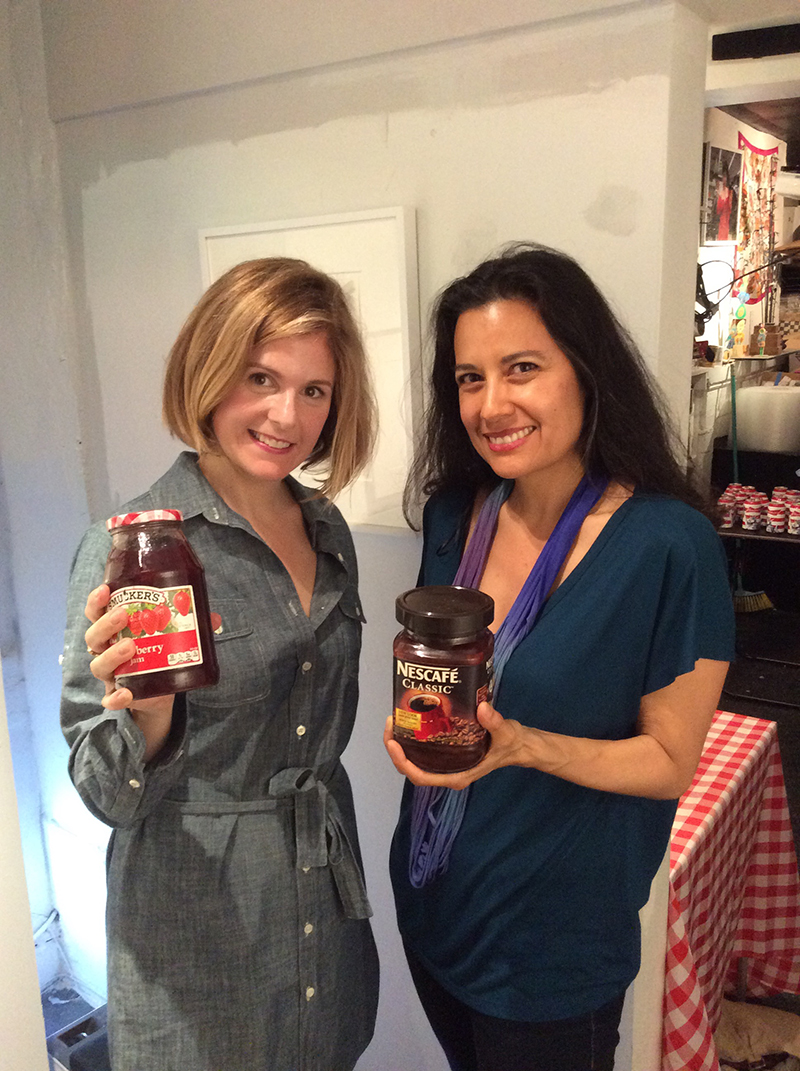
donated jars of home made marmelades (Italian prunes with little sugar in recycles glass jars that don't indicate their content)

DANIEL SPOERRI AND CLAUDE TOREY,
HERISSON PRESSE ET OUI!, 1974, MIXED MEDIA AND COLLAGE ON BOARD, CM 58 x 78 x 18 (collection Rainer Ganahl)
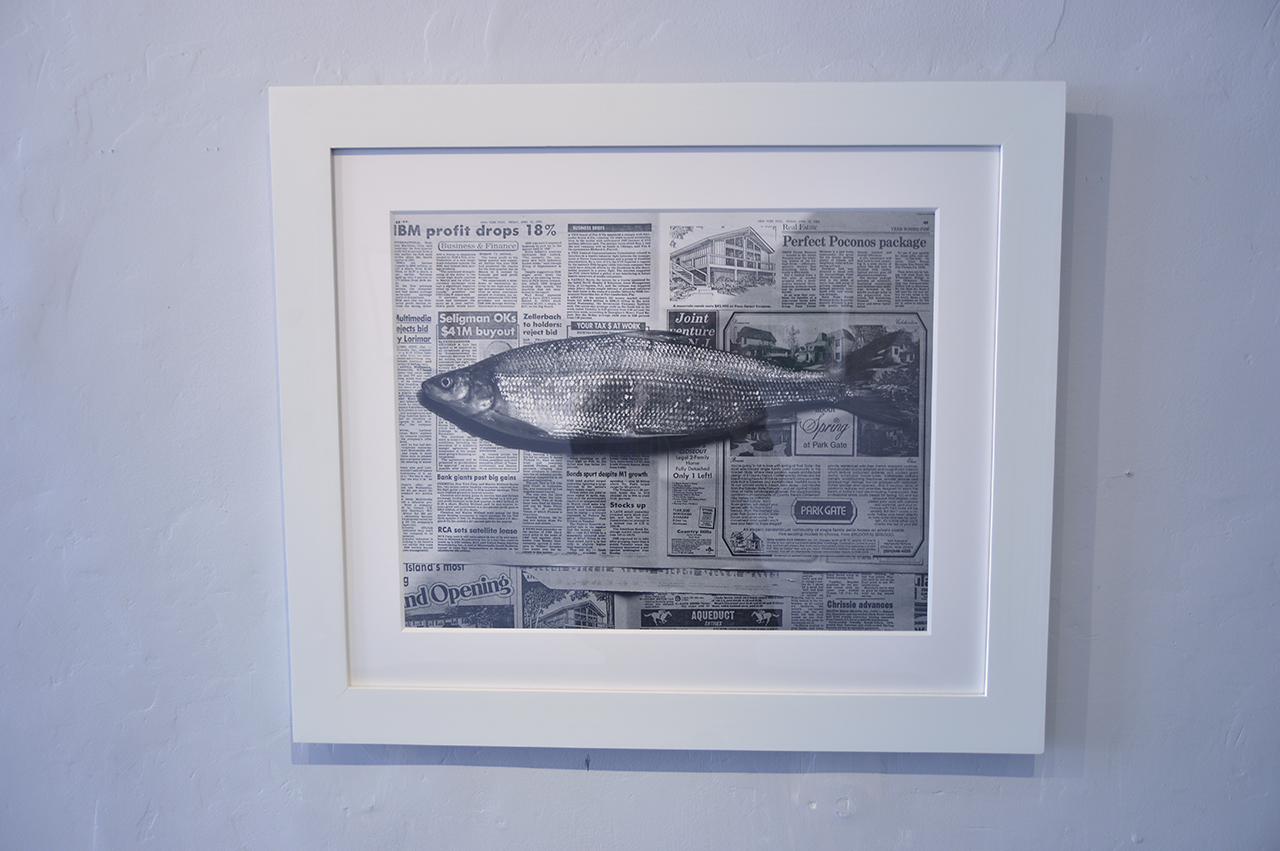
Robert, Mappelthorpe, 1885 , 50 x 60 inches, photography (collection Rainer Ganahl)
Marcel Ducham,, bouche-evier, (sink stopper / drain stopper), bronze 1964, (collection Rainer Ganahl)
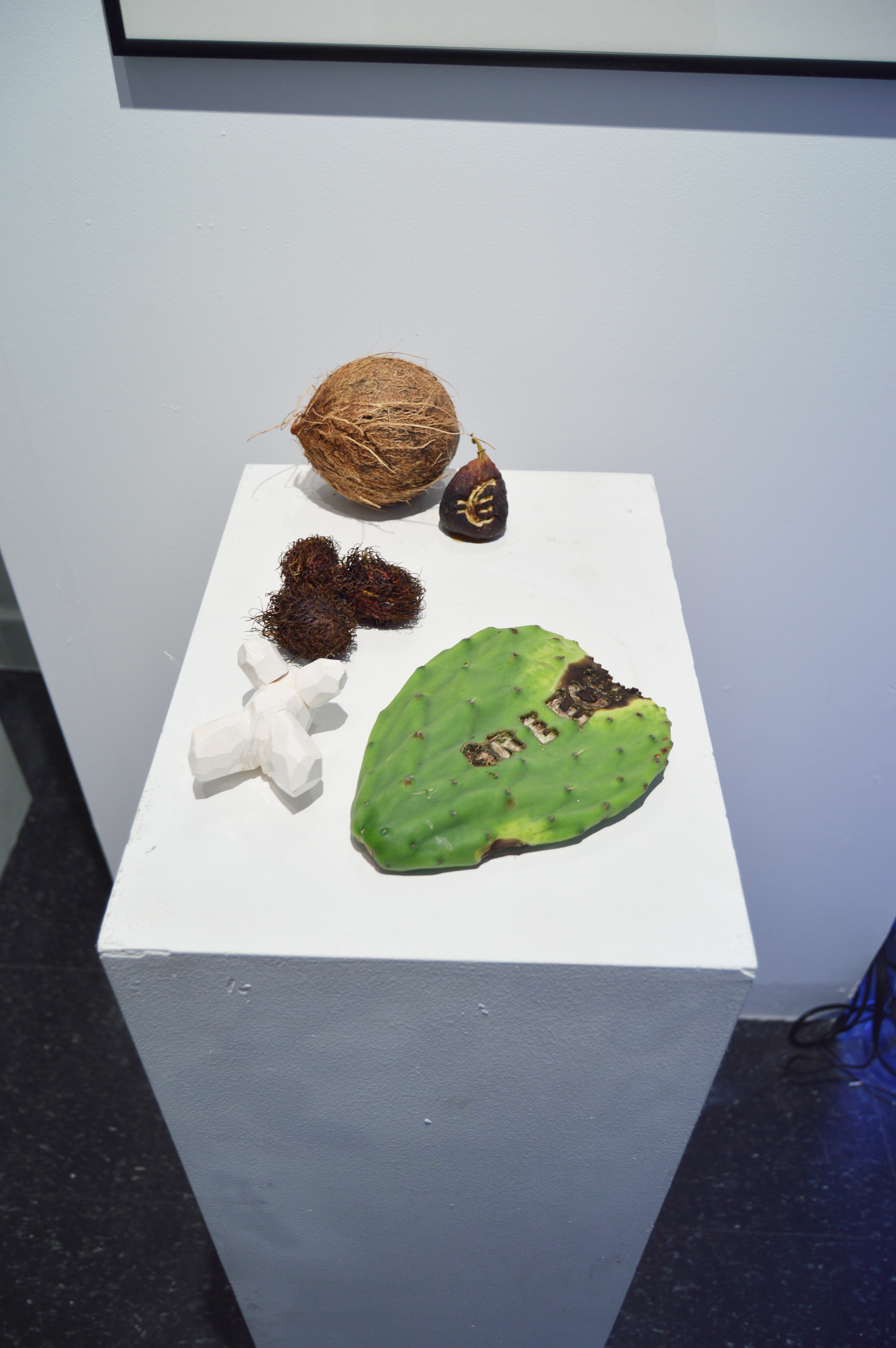
Rainer Ganahl
Credit Crunch, Greece, 2015
// here and there curating... /
2017
STOP WORK ORDER @ THE SCHLOSS
recent trades between Rainer Ganahl and his artist/friends
New York City. April 2017
this show was made as a house warming party and was inaugurated with the help of Thea Westreich (collector and art adviser) as cook.
the curatorial aspect overlapped with my love for art collecting, addressing artist friends willing to swop art works outside any monetary exchange. some of the subtleties are addressed here based on my experience with trading art between artists written for a Swiss context.
PLEASE, TRADE WITH ME / https://ganahl.info/pleasetradewithme.html
David Adamo
Saâdane Afif
Polly Apfelbaum
Kerstin Brätsch
Whitney Claflin
Liza Craft
Devon Dikeou
Cheryl Donegan
Peter Fend
Jonah Freeman
Liam Gillick
Joseph Grigely
Matthew Higgs
Robert Janitz
Jutta Koether
Margaret Lee
Amy Lien
Jason Loebs
Craig Kalpakjian
Josh Kline
Udomsak Krisanamis
Tobias Madison
Nick Mauss
Tracy Molis C
Cary Leibowitz
Kayode Ojo
Ken Okiishi
Anna Ostoya
Dan Perjovschi
Jimmy Raskin
John Riepenhoff
Walter Robinson
Zoe Pettijohn Schade
Karin Schneider
Carol Szymanski
Trevor Shimizu
Marianne Vitale
Klaus Weber
Pedro Wirz
B Wurtz
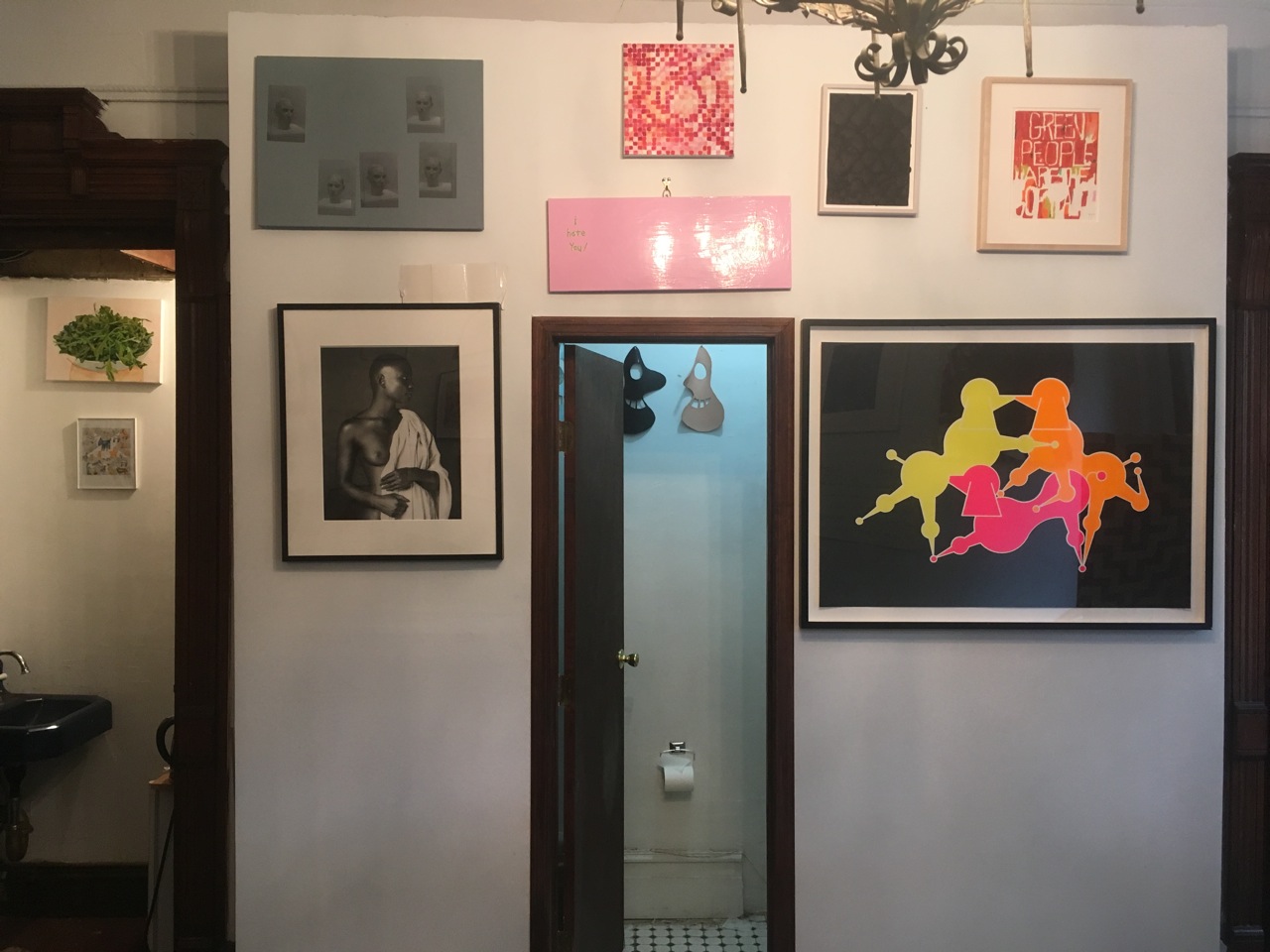
------------------------------------------------left small room
Walter Robinson - painting
Polly Apfelbaum - COLLAGE
------------------------------------------------front wall left to right top down
Nick Mauss - paint and silkscren on wood
Jutta Koehter - painting
William Pope L, painting, (not a trade - was in my collection)
William Pope L , gouache (not a trade - was in my collection)
Cary Leibowitz -painting
Robert Mappelthorp - photograph
General Idea - silkscreen (not a trade - was in my collection)
------------------------------------------------------works seen through middle door
Pedro Wirtz, silicon
2018
THE ROUTE OF FRIENDSHIP IS RUNNING INTO A BIG, BEAUTIFUL WALL,
MAKE BRUTALISM BEAUTIFUL AGAIN , MEXICO CITY, 1968/2018
STRANGETEACHING.INFO
An PERMANENT open air exhibition with 56 international artists curated by Rainer Ganahl, April 29th, 2018 –
This show is part of my STRANGE TEACHING PROJECTS. I picked Mexico city because of 1968 – the Olympic Games with Carlos and the athletes support for the black liberation movement as well as the incredible internationally barely know student massacre with about 1000 casualties. Hence, this show that had a clear political pivot, I had not institutional support and the event was basically illegal since one cannot just attach artworks without any permits permanently on city ground in concrete along a major city tangent. Hence, this show doesn’t come with geo-markers and people need to find it but can see it reassembled on my (curated) web site. To a certain degree I cannot even "proof" that the exhibition and artworks exist or once existed where they claim they are / were which brings us back to the tragic fates of all the killed and disappeared protesters of the 1968 Mexico massacre at the Three Cultures Plaza. (How telling is that location - - by the way, not a place to hang out or wonder around alone – Tres culturas because of the pre-columbian clture, the colonia culture, and the current culture)
https://ganahl.info/amistad.html
An PERMANENT open air exhibiton with 56 international artists curated by Rainer Ganahl, April 29th, 2018 – FOREVER
In 1968, Mexico City hosted the Olympic games which was one of the trggers for the rapid urbanization of the city. The event also served as a stage for a diverse number of protests, initiated by groups of workers and students in Mexico and elsewhere. In the years of the games, a symbol of peace, the Mexican government massacred around a thousand students, who were indiscriminately mowed down by government forces during prostests. Political tensions arose due to massive spending for the games and any resistance to improve the situation for labor and farmers in combination with state represion. To this day, there is still not full clarity and research only little acknowledgement of guilt from the side of the Mexican government and the special forces involved. The Olympics are also remembered for the US athletes John Carlos and Tommie Smith, who greeted their medals with the Black Power Salute, a raised fist and a lowered head.
Mexico City also staged an ambitious international art exhibit with the telling name Route of Friendship consisting exclusively of large concrete sculptures that where supposed to be colored and placed along a newly inaurated highway. Today, most of these sculptures are still in place but have been absorbed by the city.
In this context Hegel’s idea of historical repetition as a farce is proven wrong one more time. Fifty years later racial tension in the USA are again in the open and expressed with Black Power symbols at sports events. Donald Trump, the most divisive president of the USA in many decades, is in the business of constructing a “big, beautiful wall with Mexico” and implements the exit from international trading deals that include Mexico and the rest of the world according to his “America First” logic. ALSO, while installing the exhibtion in Mexico, scores of stundent protesters where massacred in Nicaragua. (see REPETITION). All this is not a farce. It comes with the same force and ferocity and destroys lives the same way it did 50 years ago.
For this show, I take up the original idea of the route of friendship and invite artists to place works made of concrete along a new route. With no productions budget and no permits, artists are asked to install works clandestinely along a traced path beteween the Plaza de las Tres Culturas and The US embasy. The works are mostly made of concrete, and placed without an labeling in an undiscloed palce on the route to be absorbed by its regular surrounding. The show has no ending and some of the works that are less ephemeral are ment to be forever. It is the task of each participant to find a way to insert him or herself into public space through Mexico City along the newly defined route. Unfortunately, these new Friendship sculptures come in a time of open chauvinist hostilities, new political formations of fascisms and a rejection of globalist views of an open world.
The project space, LADRON galeria, (www.ladrongaleria.com) is documenting the final works - for a couple of weeks starting with a opening party on April 28th.
A publication will follow.
To few the origianl ROUTE OF FRIENDSHIP sculpture, see this amazing video- 1968 Route of Friendship Sculptures
ARTISTS stiing onE OF the original 1968 RAOD TO FREINDSHIP SCULPUTURES.
Rainer Ganahl, USA/ Austria
DRAIN STOPPER 1964 / 1967 / 1968, 2018
Didn’t Trump want to "drain the swamp" ? ( I happen to also be in possession of an authentic edition of Duchamps sink / drain stopper as there is one at MOMA listed as Bouche-Evier 1964 - My edition was included in the TABLEAU (food themed) show at Kai Matsumiya, listed below were it was shown in the sink, as part of my curated exhibition
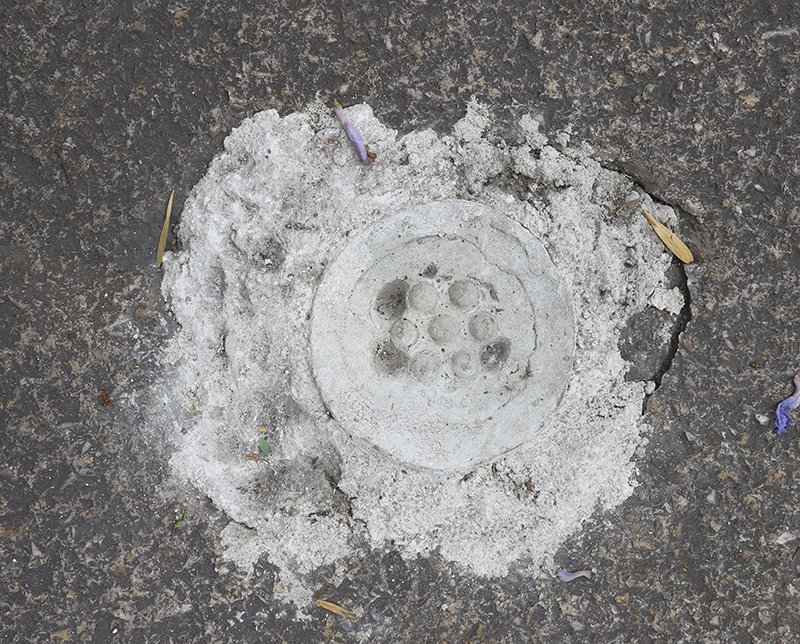
related work made in Mexico by Rainer Ganahl
REPETITION, Mexico City 2018 or see directly on youtube
Celebrating Brutalism, MAKE BRUTALISM BEAUTIFUL AGAIN, A MANIFESTO, Mexico City, 2018 or youtube
Ariel Schlesinger, Israel
Stolperstein
referencing the STOLPER STEIN - a couple stone placed in Berlin to commemorate the deported and mostly killed people between the 1930s and 1945) .placed outside the houses these people lived. . BUT WITOUT a name. .stoplerstein.. a stone that is n your way and makes you fall over
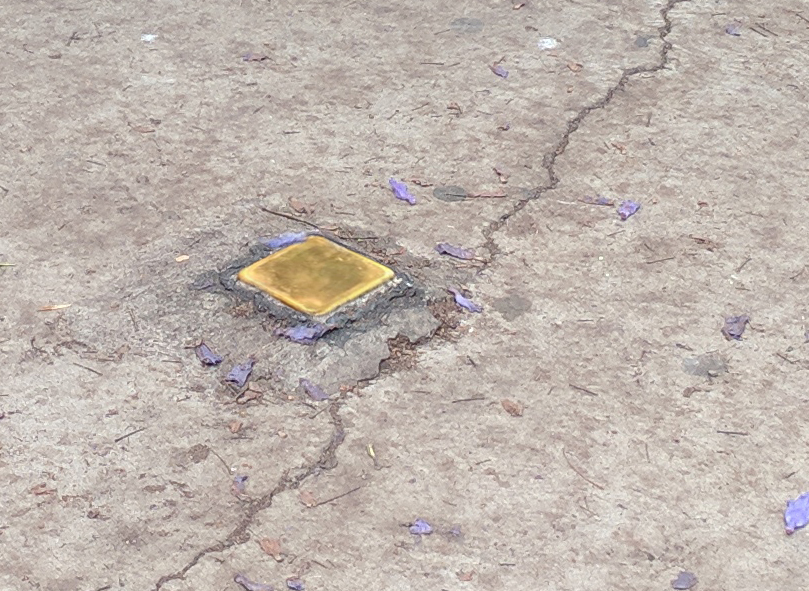
Damián Ortega, Mexico
Xibalba, 2017
Glass, blood build into concrete
The name of helll in pre-Columbian Culture
2019
- in the making -
Teheran - Chambers d’amiss
Exhibiting in friends homes
STRANGETEACHING.INFO
In 1986 jan Hoet, director the the art museum in Gent curated a show with over 50 (mostly male) well known artists throughout the city of Gent in 58 private residencies of mostly collectors with the telling name chambers d’amis that translates as a friends’room, This was a novum because unlike the 1970s famous APTART exhibitions that took place for reasons of censorship and political repression in Soviet time Moscow, Gent had no ideological problems with art. the city filled with Museums and cultural institutions open to contemporary art also had no logistical problems for the many celebrity artists it showed including Bruce Nauman. ,Laurende Wiener, Paul Thek , Mario Merz, Dan Grsham and many more.
For a next installment of my strange teaching projects afte Mexico City, I propose TEHERAN - Chambers d’amis / Exhibiting in friends homes with students from various friends’ art students from various art academies and those who study with me. Given the fact that the US president has broken off a stabilizing international non-nuclear adams deal with Itan and has substantially re-isolated Iran’s international standing that has already suffered self-isolation since the Iran revolution of 1978 that has brought a repressive ans authoritarian fundamentalist regime to rule thst has no problems to crack down on its protesting students with lethal force as it did only in recent years the spirit of our projected exhibition will resemble more the secretive exhibitions of the APTART period in Soviet Moscow than to the celebration of the greatest of a generation of artists throughout a city in some of the wealthy residences of the Belgian capital of the art of that moment ? There for it is absence of any financial or institutional support thot we have to literally rely on local friends that will host each of our participants which i want to complement with Iranian artists we can hopefully convince to participate.
This chambres d’amis concept speaks of friendship and thus will also be our artistic goal - to connect with local people, independent of art related or not. .The task of everybody participating will consist in it only make a new work during our two weeks stay but also to find a host for a final three day exhibition that should go unnoticed by the local authorities. Like in Mexico City where works were made in concrete and placed illegal indefinitely without specific indication along a specific path on central roads and avenues and made available for viewing only on line and in a forthcoming publication, the splintered up Teheran show too will not be traceable by anybody except by those who know and reassembled on line and later in publication.
participant artists / student-artist: i will invite friend-artist professors to invite a few of thseir students ( Heimo Zobernick, Academy of fine arts, Vienna) Jutta Koether,Hamubrg Academy of fine arts); Olaf Nicolai (Munich Academy of fine arts), Gregor Schneider,( Duesseldort Academie of fine arts) -
reference:
“Chambres d’amis”
Museum van Hedendaagse Kunst, Ghent, but hosted in 58 private houses in Ghent
21th June – 21th September, 1986
Curator: Jan Hoet
Artists: Carla Accardi, Christian Boltanski, Raf Buedts, Daniel Buren, Michael Buthe, Jacques Charlier, Nicola de Maria, Luciano Fabro, Günther Förg, Jef Geys, Dan Graham, Milan Grygar, François Hers, Kazuo Katase, Niek Kemps, Joseph Kosuth, Jannis Kounellis, Bertrand Lavier, Sol Lewitt, Danny Matthys, Gerhard Merz, Mario Merz, Marisa Merz, Helmut Middendorf, Juan Muñoz, Hidetoshi Nagasawa, Bruce Nauman, Maria Nordman, Oswald Oberhuber, Heike Pallanca, Panamarenko, Giulio Paolini, Royden Rabinowitch, Norbert Radermacher, Roger Raveel, Wolfgang Robbe, Claude Rutault, Reiner Ruthenbeck, Remo Salvadori, Rob Scholte, Ettore Spalletti, Paul Thek, Niele Toroni, Charles Vandenhove, Philip Van Isacker, Jan Vercruysse, Jean-Luc Vilmouth, Martin Walde, Lawrence Weiner, Robin Winters, Gilberto Zorio.
-------------
Kathy Battista:
I'd love to hear how curating fits into your practice.
Rainer Ganahl:
Being the kind of artist I am, there is nothing "off limits" from what I incorporate into my work: Studying foreign languages, selling my library, bicycling, falling in love and on to real estate investments, learning how to paint, strange teaching, my own kids, dreaming, political activism, my students, art collecting, journalism, oral histories of Nazi genocide and more. Hence, curating is part of my occupations as an artist.
I welcome curatorial activities in various ways and invite artists also to collaborate with me in making work. Since my spell check doesn’t recognize the word curating, I don’t hesitate to call these selected collaborations as a form of curating. For example, a work I did in 2017, called I wanna be Alfred Jarry is based on a historical fact that this proto-dadaist fabulous poet/artist/enfant terrible at the turn of the century was destroying a painted portrait of himself made in 1895 by Henri Rousseau, known also as the Le Douanier. Jarry didn’t like it so he destroyed it without making any reproduction. Therefore, I ask various painter/artist/friends to paint me in the style of Rousseau as Alfred Jarry and again gift me the result to become “my” art work which I promise not to sell.. This growing series is entitled Rainer Ganahl, For Alfred Jarry, Henry Rousseau, Various Painters, 1895/2012 of oil or acrylic paint on canvas - various sizes https://ganahl.info/jarryrousseau.html ) I have more work groups that function along a similar logic. (selling my library: having proper tea with…; In the task school of Trevor Shimizu; etc.)
Rainer Ganahl, For Alfred Jarry, Henry Rousseau, Elliot Jumal Robbins, 1895/2018
acrylic spray paint on canvas 16 x 20inches
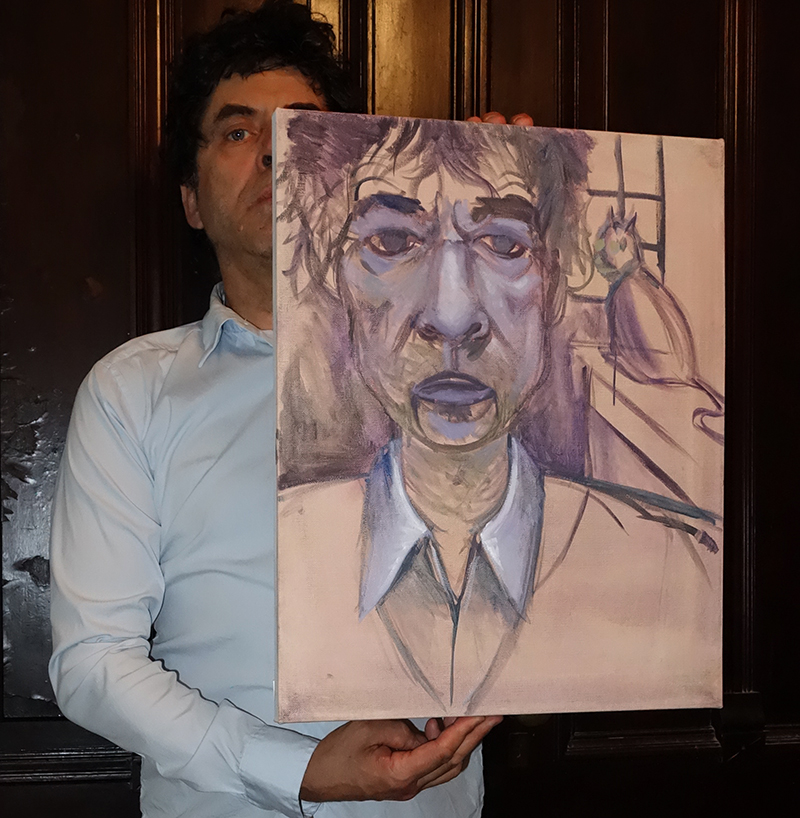
But speaking of curating in a more common sense/understanding, from the very beginning of my functioning as an artist, I have been curating shows around my interests, my own work, my own social contacts knocking mostly but not exclusively on the doors of my artist-friends. Thus an interesting dialog started, overlapping more often than not with my parallel passion for art collecting, whether via the medium of legal tender or artist trades and favors like offering them a roof over their heads. But independent curatorial formulations that result from invitations by galleries or my Strange Teaching Art projects, ignite also ideas for new works and dialogues between participating artists.
Below see my curated samples.
Kathy Battista:
I'd like for each of you to speak about curating as an artistic medium.
Rainer Ganahl:
To define curating not only as a practice artists like to engage with but also as an artistic medium is interesting. It complicates and multiplies the artistic field with even more artists who already find it harder and harder to differentiate from all sorts of cultural activities at large that migrate across all public domains: Misreading Beuys, I get sometimes the impression, that we are all artists, and we curate everything, from art to music, from audiences to apartments, from our lives and our foods, to our lovers and our lies. Hence, I hope I don't disappoint here my hosts but I think its time to pull the breaks on curating.
Already, we have outlived our curiosity for any medium and can let McLuhan rest in peace. Screens and connectivity are everywhere, their messages are oppressive at best, entertaining as worst. Not even a transatlantic flight saves us from curated omnipresent life content. Now, we even have a president who twitters as message and medium to curate his world of alternative facts and fake news and is about to customize his own Supreme Justice along the lines of Trump loyalty, Trump needs, Trump tweeds and Trump family interests.
On the other end, curatorial programs are mushrooming, feeding and stuffing a corporate art industry that needs Freeports, investment vehicles, industry consolidations, art consulting, art placement and art lending schemes. Very few alumni have curated mega-shows from Venice to Kassel (but I assume it is a global phenomena) which demonstrate the irrelevance of such programs.
Thanks to online art information sharing and trading, there is no necessity or little interest left to periodically compare with the help of large state funding the status quo of different national art productions. That was the funding idea many decades ago in the aftermath of nation building (Venice), nation re-building after WWII (documenta) and nation or city consolidations (see the many biennials created from the 1990s on) to also join the cultural jet set and help create a local market. The current Cleveland Triennial and other American curatorial heaving liftings can be seen as re-vitalization efforts to re-place former industrial hubs and centers of cultural wealth back on the map since we usually only fly over them.
It is noticeable to observe how even mega events like the Berlin Biennial or Europe’s Manifesta got already over a decade ago tired of the professional star curators and let their shows run by CELEBRITY ARTISTS or even CELEBRITY CELEBRATING magazine editors from outside the art-only specter TO UP THE downing trend for former curatorial authorities or- since the 2000s, - already ersatz-fetish-stand-ins who alrady dressed up in corporate attire. I can’t keep myself from reasoning, that this might just have just cover up the fact the paying parties - an ever larger and larger list of state, city and private donors - had anything else but attendence and marketing resuls on their minds. Nobody was paying attention to art works and artist voices anymore and that for a long time. It was not anymore about art, it stopped even being about the show, nor about the curator. It became about the importance of AN EVENT WHERE ANYTHING IS GOOD TO PROP UP CELEBRITY ATTENTOIN AND RISE ALL OVER CITY ATTENDANCE. Now even this music, starting in the 2000s has come to an echoless end and we really have ran out of laughter and spite.
Therefore, I'd like to rather remind people of a now nearly passed time, when people without any or barely any specific formal artistic or curatorial formation got caught up in the institutional and financial misery of artist friends to help them to create events and find ways to show art in spite of a total absence of much support or interest from the outside. How different is that from today, when smart, young, well dressed armies of young fabulously great looking, well educated and internationally trained curatorial talents are sorting through the canvases of all art worlds of the globe and bring home idea and names, to curate and curate and curate across an ever well defined garden of themes that span from the political to the scientific, the poetic to the absurd, the meaning full to whatever the trends dig up, anticipate, re-invent or simply repeat. The shows are then artist, text or ideology centric, well funded or under-funded, with projects that are glocal, local, global, and are uber-sensitive to gender, class or identity priorities. These curated events also catering to either minority or more popular interests that are easier to market and monetarize and can be finally characterized as art market friendly or openly art market hostile.
But the trend for curating – at last from my perspective – is going in the right direction: downhill. The hight days are over when in same cases, the curators’ names became synonymous with the art of an epoch and rivaling with the name of an entire paying city. Okwui was Kassel, Bonami was Venice, and Kassel was Koenig – thought now we are about to let even those markers go and simply don’t care because art fairs are spreading and tiring us out. Art fairs at least contain and pack curatorial ambitions only into their margins for the high entrance paying masses and exhibitor lists are currated I do not lament the fading of the supreme power-curator and also observe, that celebrity culture is better served with uncurated art fairs, and mega-galleries for rent for Gucci and other high flyers. By the way, this might explain, why I have been recently fully absorbed with making fashion shows (commedesmarxits.com; guccipleasehelpme.com)
In order not to alienate curators or even artist-curators ( I have to say, I have even less tolerance for them when they really identify with that job on a grand scale) I try to end here on a quasi romantic wishful and nostalgic point concerning curatorial work – AND YES, CURATING IS NEEDED.
I had the chance to work with Harald Szeemann who invited me to three of his large biennials and nation specific shows, including his very last one, Belgique visionaire, at the Palais de Beaux Arts in Brussels. For each show, Harald spent nearly an entire afternoon with me – alone and with no curatorial assistance as it has later become common - and wanted to genuinely know what I was doing as an artist, what I wanted to do and how he could help me to do it. As somebody who departed from classical art media and object oriented thinking, using books and studies, conversations and dialogues, talks and conferences as well as curating as part of my work at a time, I had to really explain why I called my preoccupations and fabrications art. I needed his patience and understanding, his capacity and Swiss attention to detail to make things happen. Today, when curators contact me and my friends, they want something specific to fit their ideas, their computer outlined shows. Gone are the long discussions, the endless (unfortunately smoke filled) evenings of brainstorming and adventuring with open outcome. It was used to be fun offer convivial services as cooking, barrista-ing, DJing, partying, lecturing, studying, music playing, and other services as art but today, they have options to either outsource or in-source but these ideas now are preprogrammed and sucks. It all seems to have run its course.
HENCE: CURATING SUCKS and should suck if it is worth the very essence of the term it has swallowed without digestion, because the essence of CURATING is curare from the italian/ latin word to treat, to heal, to cure, to listen and to help making beautiful things possible.